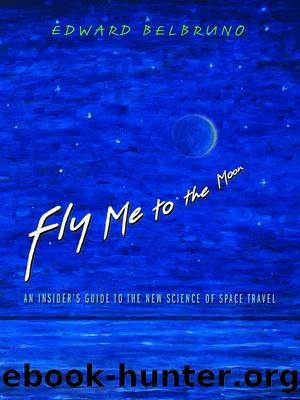Fly Me to the Moon by Belbruno Edward Tyson Neil deGrasse

Author:Belbruno, Edward, Tyson, Neil deGrasse
Language: eng
Format: epub
Publisher: Princeton University Press
Published: 2013-08-14T16:00:00+00:00
1 Unlike a Hohmann transfer, based upon modeling the motion of the spacecraft with either the Earth or the Moon in two-body problems, the ballistic capture transfer requires modeling simultaneously the Sun, Earth, Moon, and spacecraft—a four-body problem! Not too much is known about this problem.
2 No vibrations were recorded at the seismic stations when Hiten crashed, likely due to the fact that the impact didn’t have enough force.
Chapter Ten
Significance of Hiten
The route designed for Hiten’s new mission to the Moon represents a turning point in the design of lunar transfers, and transfers in general. A short history of the trajectory design of missions will put the significance of Hiten in perspective.
In the 1960s, missions to the Moon and other destinations were designed based upon Hohmann transfers, based on two-body modeling—between the spacecraft and the Earth, or the spacecraft and Moon, as we saw earlier. The resulting path to the Moon is just one half of a very thin ellipse that looks almost like a straight line (see figure 10.1). A departure from the Hohmann transfer was made in the late 1960s when Apollo went to the Moon. That was a free return trajectory. It looks similar to a Hohmann transfer on the way to the Moon, but when it arrives there it doesn’t fly by as Hohmann’s does if you don’t slow down. It loops around the Moon as shown in figure 10.2, and returns to Earth. This is called a figure-eight trajectory. It was used by Apollo for safety reasons. If the astronauts have to abort the mission due to some catastrophic failure prior to reaching the Moon, as in Apollo 13, they would automatically return to the Earth. To find this route we don’t do the modeling by breaking up the motion as two two-body problems, as with Hohmann, but model it as a three-body problem between the Earth, Moon, and spacecraft. So, the spacecraft feels the gravity of both the Earth and the Moon together at all times. This is more complicated than the Hohmann transfer and enables the free return to the Earth. The three-body problem cannot be solved using explicit formulae as with the two-body problem.1 We have to rely on the computer to model this problem and find the right trajectories.
Download
This site does not store any files on its server. We only index and link to content provided by other sites. Please contact the content providers to delete copyright contents if any and email us, we'll remove relevant links or contents immediately.
Tools of Titans by Timothy Ferriss(7811)
Turbulence by E. J. Noyes(7700)
Astrophysics for People in a Hurry by Neil DeGrasse Tyson(5000)
Secrets of Antigravity Propulsion: Tesla, UFOs, and Classified Aerospace Technology by Ph.D. Paul A. Laviolette(4990)
Design of Trajectory Optimization Approach for Space Maneuver Vehicle Skip Entry Problems by Runqi Chai & Al Savvaris & Antonios Tsourdos & Senchun Chai(4839)
Room 212 by Kate Stewart(4732)
Pale Blue Dot by Carl Sagan(4613)
The David Icke Guide to the Global Conspiracy (and how to end it) by David Icke(4377)
A Journey Through Divination and Astronomy by Publishing Pottermore(4248)
Apollo 8 by Jeffrey Kluger(3512)
Goodbye Paradise(3444)
Losing the Nobel Prize by Brian Keating(3425)
COSMOS by Carl Sagan(3346)
The Five People You Meet in Heaven by Mitch Albom(3334)
How to Read Water: Clues and Patterns from Puddles to the Sea (Natural Navigation) by Tristan Gooley(3239)
Brief Answers to the Big Questions by Stephen Hawking(3239)
How to Read Nature by Tristan Gooley(3077)
The Order of Time by Carlo Rovelli(3073)
A Brief History of Time by Stephen Hawking(2819)
